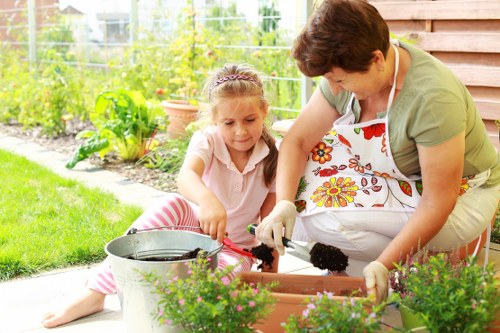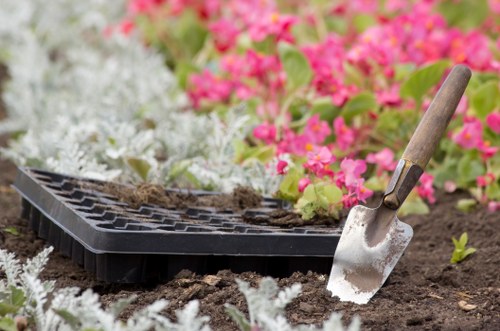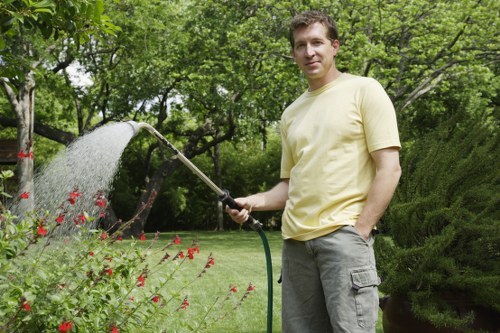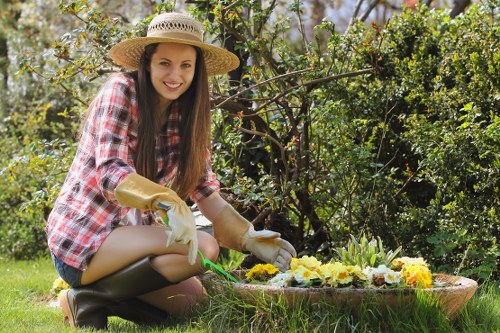Landscape Gardening in Downham: Transforming Outdoor Spaces

Introduction to Landscape Gardening
Landscape gardening is an art and science that involves designing and creating outdoor spaces that are both aesthetically pleasing and functional. In Downham, a town known for its picturesque surroundings and vibrant community, landscape gardening has become increasingly popular among homeowners and businesses alike.
The primary goal of landscape gardening is to enhance the natural beauty of an area while providing practical benefits such as improved drainage, reduced soil erosion, and increased property value. Whether you're looking to create a peaceful garden retreat, a lively outdoor entertainment area, or a sustainable eco-friendly space, landscape gardening offers endless possibilities.
Downham's climate and soil conditions are well-suited for a variety of plants and garden styles, making it an ideal location for both novice and experienced gardeners to experiment and create stunning landscapes.

Planning Your Landscape Garden
Assessing Your Space
Before starting any landscape gardening project, it's essential to assess your outdoor space. Consider factors such as the size of the area, existing vegetation, sunlight exposure, and soil quality. Conducting a thorough site analysis will help you determine what can be achieved and what limitations you might face.
Take measurements of your garden space and create a rough sketch, noting any existing features like trees, shrubs, pathways, or water sources. Understanding the natural contours and elements of your garden will guide your design decisions.
Additionally, consider the microclimates within your garden. Areas that receive full sun, partial shade, or full shade will support different types of plants and require varying maintenance levels.

Choosing the Right Plants
Selecting Plants for Downham's Climate
Selecting the right plants is crucial for the success of your landscape garden. Downham's temperate climate allows for a diverse range of plants, from colorful flowering annuals to resilient perennials and lush shrubs.
Consider native plants that are well-adapted to the local environment. Native species typically require less maintenance, are more resistant to pests and diseases, and support local wildlife, including pollinators like bees and butterflies.
When choosing plants, think about their growth habits, size, and seasonal interest. A well-planned garden will have a mix of plants that bloom at different times, ensuring year-round beauty and variety.

Design Elements in Landscape Gardening
Hardscaping Features
Hardscaping refers to the non-living elements of a garden, such as paths, patios, walls, and water features. Incorporating hardscaping elements can add structure and functionality to your landscape design.
Paths and walkways provide access to different areas of your garden and can be made from materials like gravel, stone, or paving slabs. Patios offer space for outdoor seating and entertaining, while retaining walls can help manage slopes and create flat planting areas.
Water features, such as fountains, ponds, or waterfalls, add a soothing element to the garden and can attract wildlife. These features also serve as focal points, drawing the eye and adding movement to the landscape.
Softscaping Elements
Softscaping involves the living components of a garden, primarily plants, but also includes elements like mulches and decorative stones. Proper softscaping not only enhances the garden's beauty but also contributes to its health and sustainability.
Incorporate a variety of plant types, including trees, shrubs, flowers, and groundcovers, to create layers and depth in your garden design. Use mulches to conserve moisture, suppress weeds, and improve soil quality. Decorative stones can add texture and contrast, complementing the greenery of your plants.
Lighting and Irrigation
Outdoor lighting extends the usability of your garden into the evening hours and highlights key features. Path lights, spotlights, and string lights are popular options that can create ambiance and improve safety.
An efficient irrigation system is essential for maintaining a healthy garden. Drip irrigation, sprinklers, and rainwater harvesting systems can help ensure your plants receive adequate water while conserving resources.

Maintaining Your Landscape Garden
Regular Care and Upkeep
Maintenance is a critical aspect of landscape gardening that ensures your garden remains healthy and visually appealing. Regular tasks include watering, pruning, weeding, and fertilizing.
Establish a maintenance schedule tailored to the specific needs of your plants and garden design. Consistent care helps prevent issues such as pest infestations, disease, and plant decline.
Investing time in maintenance not only preserves the beauty of your garden but also extends the lifespan of your plants and structures, providing long-term enjoyment and value.
Sustainable Gardening Practices
Embracing sustainable gardening practices can make your landscape more eco-friendly and resource-efficient. Techniques such as composting, using organic fertilizers, and selecting drought-resistant plants contribute to a healthier environment.
Implementing rain gardens, which capture and filter rainwater runoff, reduces water pollution and supports local ecosystems. Additionally, minimizing chemical use by opting for natural pest control methods promotes biodiversity and soil health.
- Composting kitchen and garden waste to enrich the soil.
- Using organic mulch to retain moisture and suppress weeds.
- Planting native species to support local wildlife.
- Installing rainwater harvesting systems to conserve water.
- Implementing integrated pest management strategies.
Seasonal Care Tips
Each season presents unique challenges and opportunities for landscape gardening. Adapting your maintenance routine to the changing weather ensures your garden remains vibrant throughout the year.
In spring, focus on planting new specimens, pruning deciduous trees, and preparing beds for flowering plants. Summer requires diligent watering, deadheading flowers, and monitoring for pests. Fall involves clearing fallen leaves, planting bulbs for next spring, and protecting plants from frost.
Winter care includes safeguarding delicate plants with mulches or coverings and planning for the upcoming gardening season. Proper seasonal care helps your garden thrive and stay resilient against environmental stresses.
Hiring Professional Landscape Gardeners
Benefits of Professional Services
While DIY landscape gardening is rewarding, hiring professional landscape gardeners in Downham can offer numerous advantages. Professionals bring expertise, creativity, and efficiency to your garden projects, ensuring high-quality results.
Professional landscapers can help you design a cohesive and functional garden plan, select appropriate plants, and implement sustainable practices. They also handle complex tasks such as hardscaping installation, irrigation system setup, and extensive plant care.
Moreover, professionals save you time and effort, allowing you to enjoy your garden without the stress of maintenance and troubleshooting. Investing in professional services can enhance your garden's beauty and value, providing long-term satisfaction.
Choosing the Right Landscape Gardening Service in Downham
Selecting a reputable landscape gardening service in Downham involves researching local providers, reviewing their portfolios, and assessing their expertise. Look for companies with positive reviews, a solid track record, and a clear understanding of your vision.
Discuss your project goals, budget, and timeline with potential landscapers to ensure they can meet your expectations. Ask for references and visit past projects to gauge the quality of their work and their ability to deliver on promises.
Effective communication and a collaborative approach are essential when working with a professional landscaper. Choose a service that listens to your ideas, offers valuable insights, and demonstrates a commitment to creating a garden that reflects your personal style and needs.
Common Landscape Gardening Styles
Downham offers a diverse range of landscape gardening styles to suit various preferences and property types. Here are some popular options:
- Traditional English Garden: Characterized by symmetrical layouts, colorful flower beds, and classic features like topiaries and pergolas.
- Modern Minimalist: Focuses on clean lines, simple plantings, and functional hardscaping elements for a sleek and uncluttered look.
- Japanese Zen Garden: Emphasizes tranquility through carefully arranged rocks, water features, and minimalist plantings.
- Wildlife Garden: Designed to attract and support local wildlife with native plants, bird feeders, and habitat features.
- Sustainable/Eco-Friendly: Incorporates sustainable practices such as rainwater harvesting, native plantings, and organic gardening methods.
Enhancing Curb Appeal
Your landscape garden plays a significant role in enhancing the curb appeal of your property. A well-designed garden creates a positive first impression, increases property value, and provides a welcoming atmosphere.
Key elements for boosting curb appeal include a balanced mix of plants, attractive pathways, properly maintained lawns, and seasonal flowers. Lighting can also highlight architectural features and create an inviting ambiance in the evenings.
Consider the overall aesthetic you wish to achieve and ensure that your garden complements your home's style and architecture. Consistency in design elements and thoughtful plant selection contribute to a harmonious and appealing exterior.
Creating Outdoor Living Spaces
Outdoor living spaces extend your home’s usable area and provide a venue for relaxation and entertainment. Integrating landscape gardening with outdoor structures like decks, patios, and pergolas creates inviting spaces for gatherings and personal enjoyment.
Furniture, fire pits, outdoor kitchens, and shade structures enhance the functionality and comfort of your outdoor spaces. Incorporating plants and natural elements into these areas blurs the line between indoor and outdoor living, fostering a seamless and harmonious environment.
Thoughtful design and strategic placement of elements ensure that your outdoor living spaces are both beautiful and practical, tailored to your lifestyle and preferences.
Seasonal Flower Displays
Seasonal flower displays add color and interest to your landscape garden throughout the year. Planning for continuous blooms involves selecting a variety of plants that thrive in different seasons.
In spring, tulips, daffodils, and crocuses bring vibrant colors to the garden. Summer offers an array of annuals and perennials like roses, lavender, and sunflowers. Fall features chrysanthemums, asters, and ornamental grasses, while winter can showcase evergreen plants and festive blooms.
Layering your plantings and incorporating flowering shrubs and trees ensure that your garden remains attractive and lively, regardless of the season.
Incorporating Hardscaping into Your Garden
Hardscaping elements provide structure and functionality to your landscape garden. Here are some key hardscaping features to consider:
- Pathways and Walkways: Facilitate movement through the garden and connect different areas.
- Patios and Decks: Offer spaces for outdoor seating, dining, and entertaining.
- Retaining Walls: Manage slopes, prevent soil erosion, and create level planting areas.
- Water Features: Include ponds, fountains, and waterfalls that add visual and auditory interest.
- Shelters and Pergolas: Provide shade and define outdoor living spaces.
Choosing the right materials and designs that complement your garden style ensures that hardscaping elements enhance rather than overpower your landscape.
Plant Selection Tips
Selecting the right plants is essential for a thriving landscape garden. Here are some tips to help you make informed choices:
- Know Your Zone: Understanding Downham's climate zone will help you choose plants that can withstand local weather conditions.
- Consider Plant Size: Ensure that plants have enough space to grow to their mature size without overcrowding.
- Diversity: Incorporate a variety of plant types, textures, and colors to create a dynamic and resilient garden.
- Maintenance Needs: Choose plants that match your maintenance capabilities, whether you prefer low-maintenance species or are willing to invest time in upkeep.
- Sustainable Choices: Opt for drought-tolerant and native plants to promote sustainability and reduce resource consumption.
Using Mulch and Soil Amendments
Mulch and soil amendments play a vital role in maintaining a healthy landscape garden. Mulch helps retain soil moisture, suppress weeds, and regulate soil temperature. Common mulch types include organic options like bark, wood chips, and compost, as well as inorganic materials like gravel or rubber.
Soil amendments, such as compost, manure, and organic fertilizers, improve soil structure, fertility, and drainage. Testing your soil and amending it based on its specific needs ensures that your plants receive the nutrients they require for optimal growth.
Regularly replenishing mulch and maintaining soil health contribute to a thriving and sustainable garden environment.
Conclusion
Landscape gardening in Downham offers endless opportunities to create beautiful, functional, and sustainable outdoor spaces. Whether you're enhancing your home's curb appeal, establishing a serene garden retreat, or designing an outdoor living area, thoughtful planning and execution are key to achieving your vision.
By selecting the right plants, incorporating essential design elements, and maintaining your garden with care, you can enjoy a vibrant and inviting landscape that reflects your personal style and meets your practical needs.
Ready to transform your outdoor space? Contact us today to start your landscape gardening journey in Downham!

